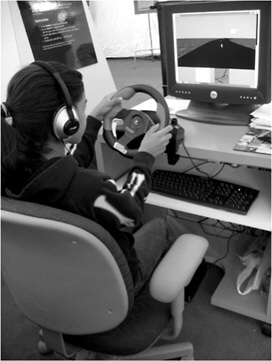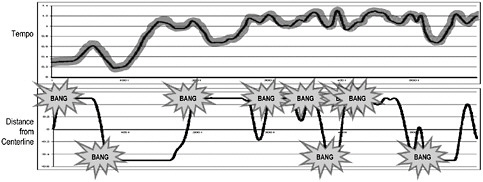Demystifying1 Music and Its Performance
ELAINE CHEW
University of Southern California
The mathematical nature of music and its imminently quantifiable attributes make it an ideal medium for studying human creativity and cognition. The architecture of musical structures reveals principles of invention and design. The dynamics of musical ensemble offer models of human collaboration. The demands of musical interaction challenge existing computing paradigms and inspire new ones.
Engineering methodology is integral to systematic study, computational modeling, and a scientific understanding of music perception and cognition, as well as to music making. Conversely, understanding the in-action thinking and problem solving integral to music making and cognition can lead to insights into the mechanics of engineering discovery and design. Engineering-music research can also advance commercial interests in Internet radio, music recommendation and discovery, and video games.
The projects described in this article, which originated at the Music Computation and Cognition Laboratory at the University of Southern California, will give readers a sense of the richness and scope of research at the intersection of engineering and musical performance. The research includes computational music cognition, expression synthesis, ensemble coordination, and musical improvisation.
ANALYZING AND VISUALIZING TONAL STRUCTURES IN REAL TIME
Most of the music we hear is tonal music, that is, tones (or pitches) organized in time that generate the perception of different levels of stability. The most stable pitch in a musical segment is known as the tonal center, and this pitch gives the key its name. Computational modeling of key-finding dates back to the early days of artificial intelligence (Longuet-Higgins and Steedman, 1971). A popular method for key-finding, devised by Krumhansl and Schmuckler (described in Krumhansl, 1990), is based on the computation of correlation coefficients between the duration profile (vector) of a query stream and experimentally derived probe tone profiles.
Theoretically Efficient Algorithms
In 2000, the author proposed a spiral array model for tonality consisting of a series of nested helices representing pitch classes and major and minor chords and keys. Representations are generated by successive aggregations of their component parts (Chew, 2000). Previous (and most ongoing) research in tonality models has focused only on geometric models (representation) or on computational algorithms that use only the most rudimentary representations. The spiral array attempts to do both. Thus, although the spiral array has many correspondences with earlier models, it can also be applied to the design of efficient algorithms for automated tonal analysis, as well as to the scientific visualization of these algorithms and musical structures (Chew, 2008).
Any stream of notes can generate a center of effect (i.e., a center of gravity of the notes) in the spiral array space. The center of effect generator (CEG) key-finding algorithm based on the spiral array determines the key by searching for the key representation nearest the center of effect of the query stream. The interior-point approach of the CEG algorithm makes it possible to recognize the key quickly and provides a framework for designing further algorithms for automated music analysis.
A natural extension of key-finding is the search for key (or contextual) boundaries. Two algorithms have been proposed for finding key boundaries using the spiral array—one that minimizes the distance between the center of effect of each segment and its closest key (Chew, 2002) and one that finds statistically significant maxima in the distance between the centers of effect of consecutive music segments, without regard to key (Chew, 2005).
The inverse problem of pitch-spelling (turning note numbers, or frequency values, into letter names for music manuscripts that can be read by humans) is essential to automated music transcription. Several variants of a pitch-spelling algorithm using the spiral array have been proposed, such as a cumulative window (Chew and Chen, 2003a), a sliding window (Chew and Chen, 2003b), and a multi-window bootstrapping method (Chew and Chen, 2005).
Robust Working Systems
Converting theoretically efficient algorithms into robust working systems that can stand up to the rigors of musical performance presents many challenges. Using the Software Architecture for Immersipresence framework (François, in press), many of the algorithms described above have been incorporated into the Music on the Spiral Array Real-Time (MuSA.RT) system—an interactive tonal analysis and visualization software (Chew and François, 2003).
MuSA.RT has been used to analyze and visualize music by Pachelbel, Bach, and Barber (Chew and François, 2005). These visualizations have been presented in juxtaposition to Sapp’s keyspaces (2005) and Toiviainen’s self-organizing maps (2005). MuSA.RT has also been demonstrated internationally and was presented at the AAAS Ig Nobel session in 2008.
Figure 1 shows MuSA.RT in concert at the 2008 ISMIR conference at Drexel University in Philadelphia. As the author plays the music (in this case, Ivan Tcherepnin’s Fêtes–Variations on Happy Birthday) on the piano, MuSA.RT performs real-time analysis of the tonal patterns. At the same time, visualizations of the tonal structures and trajectories are projected on a large screen, revealing the evolution of tonal patterns—away from C major and back—over a period of more than ten minutes.
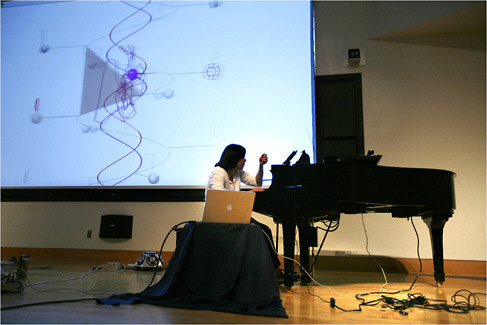
FIGURE 1 MuSA.RT in concert at the 2008 ISMIR conference at Drexel University. Source: © The Philadelphia Enquirer. Reprinted with permission.
In MuSA.RT version 2.7, the version shown in Figure 2 (as well as Figure 1), the pitch-class helix and pitch names are shown in silver, the major/minor triad helices are hidden, and the major/minor key helices, which are shown in red and blue, respectively, appear as a double helix in the structure’s core. When a note is sounded, silver spheres appear on the note name, a short-term center of effect tracks the local context, and the triad closest to it lights up as a pink/blue triangle. A long-term center of effect tracks the larger scale context, and a sphere appears on the closest key, the size of which is inversely proportional to the center of effect-key distance. Lighter violet and darker indigo trails trace the history of the short-term and long-term centers of effect, respectively
An analysis of humor in the music of P.D.Q. Bach (a.k.a. Peter Schickele) by Huron (2004) revealed that many of Schickele’s humorous effects are achieved by violating expectations. Using MuSA.RT to analyze P.D.Q. Bach’s Short-Tempered Clavier, we visualized excessive repetition, as well as incongruous styles, improbable harmonies, and surprising tonal shifts (all of which appeared as far-flung trajectories in the spiral array space) (Chew and François, 2009). Figure 3 shows visualizations of a few of these techniques.
By using the sustain pedal judiciously, and by accenting different notes through duration or stress, a performer can influence the listener’s perception of tonal structures. The latest versions of MuSA.RT take into account pedal effects in the computing of tonal structures (Chew and François, 2008). Because center of effect trails react directly to the timing of note soundings, no two human performances result in exactly the same trajectories.
We are currently working on extending spiral array concepts to a higher dimension to represent tetrachords (Alexander et al., in preparation). The resulting pentahelix has a direct correspondence to the orbifold model (a geometric model
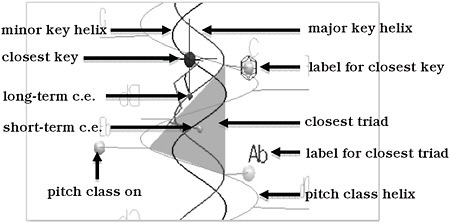
FIGURE 2 Components of the spiral array in MuSA.RT labeled. Color figure available online at http://www.nap.edu/catalog.php?record_id=13043.
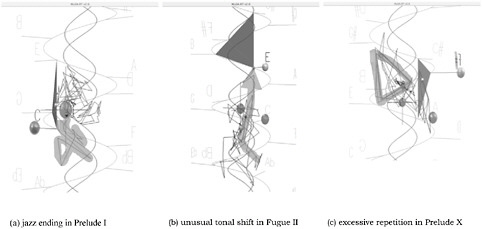
FIGURE 3 Humor devices in P.D.Q. Bach’s Short-Tempered Clavier visualized in MuSA.RT. Source: Adapted from Chew and François, 2009.
for representing chords using a topological space with an orbifold structure) (Callendar et al., 2008; Tymoczko, 2006).
EXPERIENCING MUSIC PERFORMANCE THROUGH DRIVING
Not everyone can play an instrument well enough to execute expressive interpretations at will, but almost everyone can drive a car, at least in a simulation. The Expression Synthesis Project (ESP), based on a literal interpretation of music as locomotion, creates a driving interface for expressive performance that enables even novices to experience the kind of embodied cognition characteristic of expert musical performance (Figure 4).
In ESP (Chew et al., 2005a), the driver uses an accelerator and brake pedal to increase or decrease the speed of the car (music playback). The center line segments in the road approach at one per beat, thus providing a sense of tempo (beat rate and car velocity); this is shown on the speedometer in beats per minute. Suggestions to slow down or speed up are embedded in bends in the road and straight sections, respectively. Thus the road map, which corresponds to an interpretation of a musical piece, often reveals the underlying structure of the piece.
Despite the embedded suggestions, the user is free to choose her/his desired tempo trajectory. In addition, more than one road map (interpretation) can correspond to the same piece of music (Chew et al., 2006). As part of the system design (using SAI), a virtual radius mapping strategy ensures smooth tempo transitions (Figure 5), a hallmark of expert performance, even if the user’s driving behavior is erratic (Liu et al., 2006).
CHARTING THE DYNAMICS OF ENSEMBLE COORDINATION
Remote collaboration is integral to our increasingly global and distributed workplaces and society. Musical ensemble performance offers a unique framework through which to examine the dynamics of close collaboration and the challenges of human interaction in the face of network delays.
In a series of distributed immersive performance (DIP) experiments, we recorded the Tosheff Piano Duo performing Poulenc’s Piano Sonata for Four Hands with auditory delays ranging from 0 milliseconds (ms) to 150 ms. In one experiment, performers heard themselves immediately but heard the other performer with delays. Both performers reported that delays of more than 50 ms caused them to struggle to keep time and compromised their interpretation of the music (Chew et al., 2004).
By delaying each performer’s playing to his/her own ears so that it aligned with the incoming signal of the partner’s playing (see Figure 6), we created a more satisfying experience for the musicians that allowed them to adapt to the conditions of delay and increased the delay threshold to 65 ms (Chew et al., 2005c), even for the Final, a fast and rhythmically demanding movement. Quantitative analysis showed a marked increase in the range of segmental tempo strategies between 50 ms and 75 ms and a marked decline at 100 ms and 150 ms (Chew et al., 2005b).
Most other experiments have treated network delay as a feature of free improvisation rather than a constraint of classical performance. A clapping experiment at Stanford showed that, as auditory delays increased, pairs of musi-
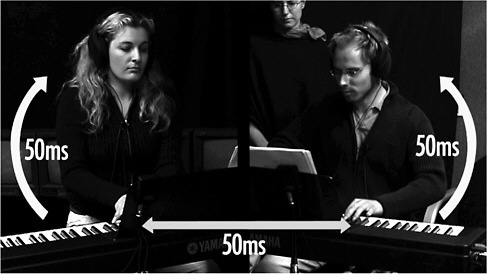
FIGURE 6 Delaying each player’s sound to his/her own ears to align with incoming audio of the other player’s sound.
cians slowed down over time. They sped up modestly when delays were less than 11.5 ms (Chafe and Gurevich, 2004). In similar experiments at the University of Rochester, Bartlette et al. (2006) found that latencies of more than 100 ms profoundly impacted the ability of musicians to play as a duo. Using more recent tools and techniques for music alignment and performance analysis, we can now conduct further experiments with the DIP files to create detailed maps of ensemble dynamics (Wolf and Chew, 2010).
ON-THE-FLY “ARCHITECTING” OF A MUSICAL IMPROVISATION
Multimodal interaction for musical improvisation (MIMI) was created as a stand-alone performer-centric tool for human-machine improvisation (François et al., 2007). Figure 7 shows MIMI at her concert debut earlier this year.
MIMI takes user input, creates a factor oracle, and traverses it stochastically to generate recombinations of the original input (Assayag and Dubnov, 2004). In previous improvisation systems (Assayag et al., 2006; Pachet, 2003), performers reacted to machine output without prior warning. MIMI allows for more natural interaction by providing visual cues to the origins of the music being generated and by giving musicians a 10-second heads up and review of the musical material.
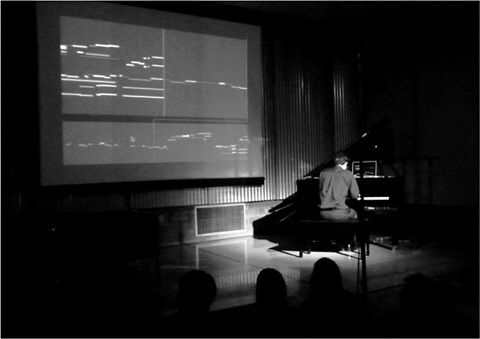
FIGURE 7 MIMI’s concert debut at the People Inside Electronics Concert in Pasadena, California, with Isaac Schankler. Photo by Elaine Chew.
MIMI’s interface allows the performer to decide when the machine learns and when the learning stops, to determine the recombination rate (the degree of fragmenting of the original material), to decide when the machine starts and stops improvising, the loudness of playback, and when to clear the memory (François et al., 2010). By tracking these decisions as the performance unfolds, we can build a record of how an improviser “architects” an improvisation. As work with MIMI continues and performance decisions are documented, our understanding of musical (and hence, human) creativity and design will improve.
OPEN COURSEWARE
Reviews of music-engineering research as open courseware can be found at www-scf.usc.edu/~ise575 (Chew, 2006). Each website includes a reading list, presentations and student reviews of papers, and links to final projects. For the 2010 topic in Musical Prosody and Interpretation, highlights of student projects include Brian Highfill’s time warping of a MIDI (musical instrument digital interface) file of Wouldn’t It Be Nice to align with the Beach Boys’ recording of the same piece; Chandrasekhar Rajagopal’s comparison of guitar and piano performances of Granados’ Spanish Dance No. 5; and Balamurali Ramasamy Govindaraju’s charting of the evolution of vibrato in violin performance over time.
ACKNOWLEDGMENTS
This work was supported in part by the National Science Foundation (NSF) under Grants 0321377 and 0347988 and Cooperative Agreement EEC-9529152. Opinions, findings, and conclusions or recommendations expressed in this article are those of the author and not necessarily of NSF.
REFERENCES
Alexander, S., E. Chew, R. Rowe, and S. Rodriguez. In preparation. The Pentahelix: A Four-Dimensional Realization of the Spiral Array.
Assayag, G., and S. Dubnov. 2004. Using factor oracles for machine improvisation. Soft Computing 8(9): 604–610.
Assayag, G., G. Bloch, M. Chemillier, A. Cont, and S. Dubnov. 2006. Omax Brothers: A Dynamic Topology of Agents for Improvization Learning. In Proceedings of the Workshop on Audio and Music Computing for Multimedia, Santa Barbara, California.
Bartlette, C., D. Headlam, M. Bocko, and G. Velikic. 2006. Effect of network latency on interactive musical performance. Music Perception 24(1): 49–62.
Bugliarello, G. 2003. A new trivium and quadrivium. Bulletin of Science, Technology and Society 23(2): 106–113.
Callendar, C., I. Quinn, and D. Tymoczko. 2008. Generalized voice-leading spaces. Science 320(5874): 346–348.
Chafe, C., and M. Gurevich. 2004. Network Time Delay and Ensemble Accuracy: Effects of Latency, Asymmetry. In Proceedings of the 117th Conference of the Audio Engineering Society, San Francisco, California.
Chew, E. 2000. Towards a Mathematical Model of Tonality. Ph.D. Thesis, Massachusetts Institute of Technology, Cambridge, Massachusetts, 2000.
Chew, E. 2002. The Spiral Array: An Algorithm for Determining Key Boundaries. Pp. 18–31 in Music and Artificial Intelligence, edited by C. Anagnostopoulou, M. Ferrand, and A. Smaill. Springer LNCS/LNAI, 2445.
Chew, E. 2005. Regards on two regards by Messiaen: post-tonal music segmentation using pitch context distances in the spiral array. Journal of New Music Research 34(4): 341–354.
Chew, E. 2006. Imparting Knowledge and Skills at the Forefront of Interdisciplinary Research—A Case Study on Course Design at the Intersection of Music and Engineering. In Proceedings of the 36th Annual ASEE/IEEE Frontiers in Education Conference, San Diego, California, October 28–31.
Chew, E. 2008. Out of the Grid and into the Spiral: Geometric Interpretations of and Comparisons with the Spiral-Array Model. W. B. Hewlett, E. Selfridge-Field, and E. Correia Jr., eds. Computing in Musicology 15: 51–72.
Chew, E., and Y.-C. Chen. 2003a. Mapping MIDI to the Spiral Array: Disambiguating Pitch Spellings. Pp. 259–275 in Proceedings of the 8th INFORMS Computing Society Conference, Chandler, Arizona, January 8–10, 2003.
Chew, E., and Y.-C. Chen. 2003b. Determining Context-Defining Windows: Pitch Spelling Using the Spiral Array. In Proceedings of the 4th International Conference for Music Information Retrieval, Baltimore, Maryland, October 26–30, 2003.
Chew, E., and Y.-C. Chen. 2005. Real-time pitch spelling using the spiral array. Computer Music Journal 29(2): 61–76.
Chew, E., and A.R.J. François. 2003. MuSA.RT—Music on the Spiral Array. Real-Time. Pp. 448–449 in Proceedings of the ACM Multimedia ‘03 Conference, Berkeley, California, November 2–8, 2003.
Chew, E., and A.R.J. François. 2005. Interactive multi-scale visualizations of tonal evolution in MuSA. RT Opus 2. ACM Computers in Entertainment 3(4): 16 pages.
Chew, E. and A.R.J. François. 2008. MuSA.RT and the Pedal: the Role of the Sustain Pedal in Clarifying Tonal Structure. In Proceedings of the Tenth International Conference on Music Perception and Cognition, Sapporo, Japan, August 25–29, 2008.
Chew, E., and A.R.J. François. 2009. Visible Humour—Seeing P.D.Q. Bach’s Musical Humour Devices in The Short-Tempered Clavier on the Spiral Array Space. In Mathematics and Computation in Music—First International Conference, edited by T. Noll and T. Klouche. Springer CCIS 37.
Chew, E., R. Zimmermann, A.A. Sawchuk, C. Kyriakakis, C. Papadopoulos, A.R.J. François, G. Kim, A. Rizzo, and A. Volk. 2004. Musical Interaction at a Distance: Distributed Immersive Performance. In Proceedings of the 4th Open Workshop of MUSICNETWORK, Barcelona, Spain, September 15–16, 2004.
Chew, E., A.R.J. François, J. Liu, and A. Yang. 2005a. ESP: A Driving Interface for Musical Expression Synthesis. In Proceedings of the Conference on New Interfaces for Musical Expression, Vancouver, B.C., Canada, May 26–28, 2005.
Chew, E., A. Sawchuk, C. Tanoue, and R. Zimmermann. 2005b. Segmental Tempo Analysis of Performances in Performer-Centered Experiments in the Distributed Immersive Performance Project. In Proceedings of International Conference on Sound and Music Computing, Salerno, Italy, November 24–26, 2005.
Chew, E., R. Zimmermann, A. Sawchuk, C. Papadopoulos, C. Kyriakakis, C. Tanoue, D. Desai, M. Pawar, R. Sinha, and W. Meyer. 2005c. A Second Report on the User Experiments in the Distributed Immersive Performance Project. In Proceedings of the 5th Open Workshop of MU-SICNETWORK, Vienna, Austria, July 4–5, 2005.
Chew, E., J. Liu, and A.R.J. François. 2006. ESP: Roadmaps as Constructed Interpretations and Guides to Expressive Performance. Pp. 137–145 in Proceedings of the First Workshop on Audio and Music Computing for Multi-media, Santa Barbara, California, October 27, 2006.
François, A.R.J. In press. An architectural framework for the design, analysis and implementation of interactive systems. The Computer Journal.
François, A.R.J., E. Chew, and C.D. Thurmond. 2007. Visual Feedback in Performer-Machine Interaction for Musical Improvisation. In Proceedings of International Conference on New Instruments for Musical Expression, New York, June 2007.
François, A.R.J., I. Schankler, and E. Chew. 2010. MIMI4x: An Interactive Audio-Visual Installation for High-Level Structural Improvisation. In Proceedings of the Workshop on Interactive Multimedia Installations and Digital Art, Singapore, July 23, 2010.
Huron, D. 2004. Music-engendered laughter: an analysis of humor devices in P.D.Q. Bach. Pp. 700–704 in Proceedings of the International Conference on Music Perception and Cognition, Evanston, Ill.
Krumhansl, C. 1990. Cognitive Foundations of Musical Pitch. Oxford, U.K.: Oxford University Press.
Liu, J., E. Chew, and A.R.J. François. 2006. From Driving to Expressive Music Performance: Ensuring Tempo Smoothness. In Proceedings of the ACM SIGCHI International Conference on Advances in Computer Entertainment Technology, Hollywood, California, June 14–16. 2006.
Longuet-Higgins, H.C., and M. Steedman. 1971. On interpreting Bach. Machine Intelligence 6: 221–241.
Pachet, F. 2003. The continuator: musical interaction with style. Journal of New Music Research 32(3): 333–341.
Sapp, C. 2005. Visual hierarchical key analysis. ACM Computers in Entertainment 3(4): 19 pages.
Toiviainen, P. 2005. Visualization of tonal content with self-organizing maps and self-similarity matrices. ACM Computers in Entertainment 3(4): 10 pages.
Tymoczko, D. 2006. The geometry of musical chords. Science 313(5783): 72–74.
Wolf, K., and E. Chew. 2010. Evaluation of Performance-to-Score MIDI Alignment of Piano Duets. In online abstracts of the International Conference on Music Information Retrieval, Utrecht, The Netherlands, August 9–13, 2010.

